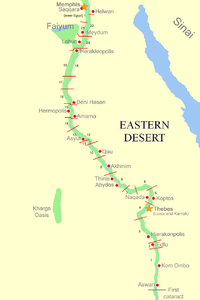
Ta-Seti
Encyclopedia

Nome (Egypt)
A nome was a subnational administrative division of ancient Egypt. Today's use of the Greek nome rather than the Egyptian term sepat came about during the Ptolemaic period. Fascinated with Egypt, Greeks created many historical records about the country...
(administrative division) in Ancient Egypt
Ancient Egypt
Ancient Egypt was an ancient civilization of Northeastern Africa, concentrated along the lower reaches of the Nile River in what is now the modern country of Egypt. Egyptian civilization coalesced around 3150 BC with the political unification of Upper and Lower Egypt under the first pharaoh...
. Ta-Seti also marked the border area towards Nubia
Nubia
Nubia is a region along the Nile river, which is located in northern Sudan and southern Egypt.There were a number of small Nubian kingdoms throughout the Middle Ages, the last of which collapsed in 1504, when Nubia became divided between Egypt and the Sennar sultanate resulting in the Arabization...
.
Geography
Ta-Seti was the earliest Nubian Kingdom, dated 3,700 BCE. Bruce Williams, a curator at the University of ChicagoUniversity of Chicago
The University of Chicago is a private research university in Chicago, Illinois, USA. It was founded by the American Baptist Education Society with a donation from oil magnate and philanthropist John D. Rockefeller and incorporated in 1890...
, was instrumental in discovering numerous artifacts related to the material culture that had been found there by a previous archeologist.
The area of the district was about 2 cha-ta (about 5,5 hectare / 4,8 acres, 1 cha-ta equals roughly 2,75 hectare / 2.4 acres) and about 10,5 iteru (about 112 km / 69,6 miles, 1 iteru equals roughly 10,5 km / 6.2 miles) in length.
The Niwt (main city) was Abu / Elephantine
Elephantine
Elephantine is an island in the River Nile, located just downstream of the First Cataract at the southern border of Ancient Egypt. This region is referred to as Upper Egypt because the land is higher than that near the Mediterranean coast. The island may have received its name because it was a...
(part of modern Aswan
Aswan
Aswan , formerly spelled Assuan, is a city in the south of Egypt, the capital of the Aswan Governorate.It stands on the east bank of the Nile at the first cataract and is a busy market and tourist centre...
) and among other cities were P'aaleq / Philae (modern Philae
Philae
Philae is an island in the Nile River and the previous site of an Ancient Egyptian temple complex in southern Egypt...
), Sunet / Syene (modern Aswan
Aswan
Aswan , formerly spelled Assuan, is a city in the south of Egypt, the capital of the Aswan Governorate.It stands on the east bank of the Nile at the first cataract and is a busy market and tourist centre...
) and Pa-Sebek / Omboi (modern Kom Ombo
Kom Ombo
Kom Ombo or Ombos or Latin: Ambo and Ombi – is an agricultural town in Egypt famous for the Temple of Kom Ombo...
).
History
Every nome was ruled by a nomarchNomarch
Nomarchs were the semi-feudal rulers of Ancient Egyptian provinces. Serving as provincial governors, they each held authority over one of the 42 nomes into which the country was divided. Both nome and nomarch are terms derived from the Greek nomos, meaning a province or district...
(provincial governor) who answered directly to the pharaoh
Pharaoh
Pharaoh is a title used in many modern discussions of the ancient Egyptian rulers of all periods. The title originates in the term "pr-aa" which means "great house" and describes the royal palace...
.
Every niwt had a Het net (temple) dedicated to the chief deity
Deity
A deity is a recognized preternatural or supernatural immortal being, who may be thought of as holy, divine, or sacred, held in high regard, and respected by believers....
and a Heqa het (nomarchs residence).
The district's main deity was Horus
Horus
Horus is one of the oldest and most significant deities in the Ancient Egyptian religion, who was worshipped from at least the late Predynastic period through to Greco-Roman times. Different forms of Horus are recorded in history and these are treated as distinct gods by Egyptologists...
and among others major deities were Anuket
Anuket
In Egyptian mythology, Anuket was originally the personification and goddess of the Nile river, in areas such as Elephantine, at the start of the Nile's journey through Egypt, and in nearby regions of Nubia....
, Arensnuphis, Hathor
Hathor
Hathor , is an Ancient Egyptian goddess who personified the principles of love, beauty, music, motherhood and joy. She was one of the most important and popular deities throughout the history of Ancient Egypt...
, Isis
Isis
Isis or in original more likely Aset is a goddess in Ancient Egyptian religious beliefs, whose worship spread throughout the Greco-Roman world. She was worshipped as the ideal mother and wife as well as the matron of nature and magic...
, Khnum, Mandulis
Mandulis
The Temple of Kalabsha in Nubia was dedicated to Mandulis which was a Nubian form of Horus. A cult dedicated to Mandulis can also be found in Egypt, at Philae....
, Satet and Sobek
Sobek
Sobek , and in Greek, Suchos was the deification of crocodiles, as crocodiles were deeply feared in the nation so dependent on the Nile River...
.
Today the area is part of the Aswan Governorate
Aswan Governorate
Aswan Governorate is one of the governorates of Egypt. The southernmost governorate in Upper Egypt, its capital is Aswan.The Aswan Governorate borders Qena Governorate to the north, Red Sea Governorate to the east, New Valley Governorate to the west, and Sudan to the south...
.

